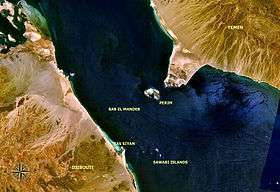Bridge of the Horns
Coordinates: 12°35′07″N 43°20′57″E / 12.58528°N 43.34917°E

The Bridge of the Horns is a proposed construction project to build a bridge between the coasts of Djibouti and Yemen, across the Bab-el-Mandeb, between the Red Sea and Gulf of Aden. It would be constructed by Al Noor Holding Investment.
By mid-2016, nothing has been heard about this project since the announcement in 2010 that Phase I had been delayed. Given the ongoing (as of July 2016) Yemeni Civil War it seems unlikely that the project will start in the near future.
Prospective structure
The length of the bridge is estimated at 29 km (18 mi), with a total cost of around USD20 billion. It has been proposed by the Dubai-based firm Middle East Development LLC headed by Tarek Bin Laden. Opening date is expected to be in the year 2020.
To clear submarine and surface vessels, the proposed bridge would have the longest suspension span in the world measuring 5 km (3.1 mi). The overall length of the entire bridge spanning the Red Sea, starting in Yemen, connecting to the island of Perim, and continuing on to Djibouti on the African continent, would be roughly 28.5 km (17.7 mi). It would have to allow very large ships of the Suezmax size in both directions simultaneously.
It was claimed that about 100,000 cars and 50,000 rail passengers would cross the bridge daily.[1]
Expected use
Twin cities, referred to as Al Noor City, would be built on either end of the bridge; the prospective site's developers indicate that they will run on renewable energy. On the Djibouti side, President Ismael Omar Guelleh granted 500 km2 (190 sq mi) to build Noor City, the first of the hundreds of Cities of Light which the Saudi Binladen Group envisions building. The developers state that they expect Noor City to have 2.5 million residents by 2025, and the Yemeni twin city to have 4.5 million, while they envision a new airport serving both cities at a capacity of 100 million passengers annually. A new highway connecting the cities to Dubai is proposed, though there are no plans for roads to connect sparsely populated Djibouti with the population centers of Addis Ababa in Ethiopia or Khartoum in Sudan. One of the uses that are imagined for this bridge is for easy transcontinental access to the Hajj in Mecca.
The Economist magazine, noting that developers state that the project will make Noor City the "financial, educational, and medical hub of Africa", commented, "Africans may wonder why the hub is not being built in a bit of Africa where more Africans live and which has food and water."[2]
Timeline
- 2009
- Original planned start[3]
- December 2009
- Yemen-Djibouti bridge gets go-ahead[4]
- June 2010
- Phase I of Yemen and Djibouti Causeway delayed[5]
See also
- Al Noor City
- List of bridge-tunnels
- Transport in Djibouti
- Saudi-Egypt Causeway - costing about $4b.
- Qatar–Bahrain Friendship Bridge
- Gibraltar Bridge
- Sunda Strait Bridge
- Strait of Messina Bridge
References
- ↑ MENAFN.com
- ↑ "Can it really be bridged?", The Economist, 31 July 2008 (subscription required)
- ↑ Borsen.dk in danish
- ↑ Yemen-Djibouti bridge gets go-ahead
- ↑ Phase I of Yemen and Djibouti Causeway delayed
External links
- COWI link in English
- , company website.
- Notice-to-Proceed Launches Ambitious Red Sea Crossing
- Tarek Bin Laden's Red Sea bridge
- Proposed Yemen-Djibouti Bridge Threatens AFRICOM Security
- Lecture on Yemen-Djibouti bridge
- Can it really be bridged?
- A Vision to Connect Africa and Asia, Spiegel Online 22 August 2008
- YouTube: Al Noor City Djibouti and Yemen - containing Bridge of the Horns
- St Tropez in the Horn?
- Bin Laden’s Bridge over Troubled Waters, 8 May 2009